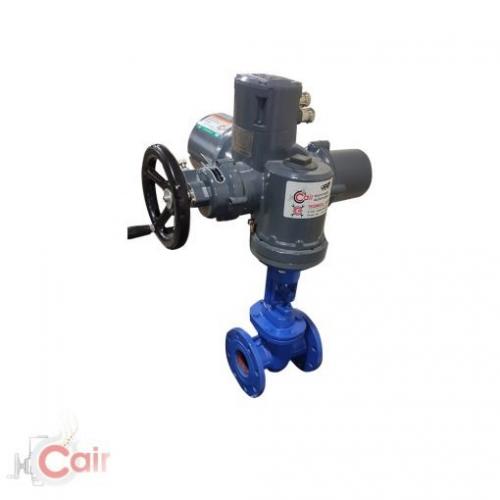All You Need To Know About Sluice Valves

Known as the sluice valve, the gate regulates the sluice. Typically, these gates are used in streams and canals to regulate water levels and flow. The sluice gate valve is also used in wastewater treatment plants.
What Is a Sluice Valve?
Gate valves or Sluice gate valves use a gate or wedge-shaped disk that slides perpendicularly to the fluid flow into or out of the pipeline. The gate valve disk is completely separated from the flow when it is fully opened. As a result, there is practically no resistance to flow. As a result, very little pressure reduction occurs as the fluid moves through the gate valve.
Sluice gate valves are commonly used in process plants to handle slurries. During operation, these valves are either fully opened or fully closed.
Throttling cannot be achieved using sluice gate valves due to their lack of accuracy. A partially open valve can cause disk and seat surface erosion, as well as vibration and noise due to the high flow velocity.
How Does a Sluice Valve Work?
A lifting gate or wedge controls the sluice gate valve, so that water can flow freely. At the top of the stem is a hand-operated wheel that raises and lowers the doors, and at the bottom is a circular or wedge gate to obstruct water flow. Due to the threaded stem, the valve must be turned several times to move from the open to the closed position, and vice versa, in order to stop water hammering.
Sluice valves have mainly two types of spindles used to raise the gate.
Raising Spindle type valve: The spindle/stem is connected to the gate in this type of valve. When operating, the spindle valve does not rotate with the handwheel but raises with the spindle.
Non- Raising spindle type valve: This type of valve design has a threaded spindle, and the gate is threaded internally where it attaches to the spindle. During operation, the stem of the valve doesn't lift from its place but rotates in place to raise the gate.
A sluice valve usually has the same size as the main valve, which has a diameter of 300 mm. The valve size is roughly two-thirds that of the main valves for larger diameters.
A valve chamber is fitted with caps or handwheels for operating the valves. A spindle with a clock or counterclockwise indication indicates which direction to open the valve.
Where Do We Use the Sluice Valve?
A sluice gate valve is used to shut off the liquid flow and cannot be used as a flow regulator. With the sluice valve completely open, there is no obstruction in the flow path, resulting in very little flow resistance. Normally, the size of the open flow path varies nonlinearly when you move the gate. As a result, the flow rate does not change uniformly with stem travel. Depending on the structure, a partially opened gate may vibrate due to fluid flow. As sluice valves have easy and simple construction, they are often used for larger pipe diameters.
Friction may become an issue under high pressure. By forcing the gate against its guide rail, the medium makes it more difficult to operate the valve. In order to decrease pressure when the gate valve is operated, large gate valves are often equipped with bypass valves controlled by smaller valves.
Sluice Valve Installation and Maintenance
When installed properly and maintained regularly, sluice gate valves are very easy to use and long-lasting.
Installation of Sluice valve.
The valves can be oriented in any direction, but if a large valve is to be used, it should be oriented upright for ease of operation.
A valve's body, stem, and disk should be checked for material before installation.
During transportation or storage, the valve should be checked for damage. The valve should also be checked for debris, rust, wrapping material, and dirt before installation.
Connect the valve and center it after ensuring that the flanges on both the pipe and the valve are in alignment. Be sure to tighten the bolts evenly so that the valve seals properly between the pipes.
Upon completion of the installation, operate the valve several times to ensure that it is in the correct position and has not moved from its desired location.
Sluice valves must be tested according to the instructions provided by the manufacturer to make sure they work properly and are capable of handling the working parameters without any problems.
Maintenance of Sluice valve.
For valves that are not regularly used, they should be operated and maintained once a month to ensure there are no blockages or wear. You should first relieve the system pressure and ensure that it is not pressurized. The bonnet and stem of the gate must be removed for inspection. After this check, inspect the sluice gate and guide for any damage or wear and refit/replace the parts.
Difference Between Gate Valve & Sluice Valve
The operation and use of sluice valves and gate valves differ somewhat. Gate valves can be used for in-line sealing and sludge disposal. Sluice gate valves are the best option when it comes to managing flow in a sluice or stream.
Cair Euromatic offers Motorized Sluice Valve which is also known Electrical Sluice Valve in India. If are you looking for Electric Sluice Valve Manufacturer & Exporter, then visit now.
Post Your Ad Here




Comments (2)
faizalmirza7
Great Information Buddy, Thanks a lot
Abid Saiyad5
Abid Saiyad
Thank you, Yunus! for sharing this information